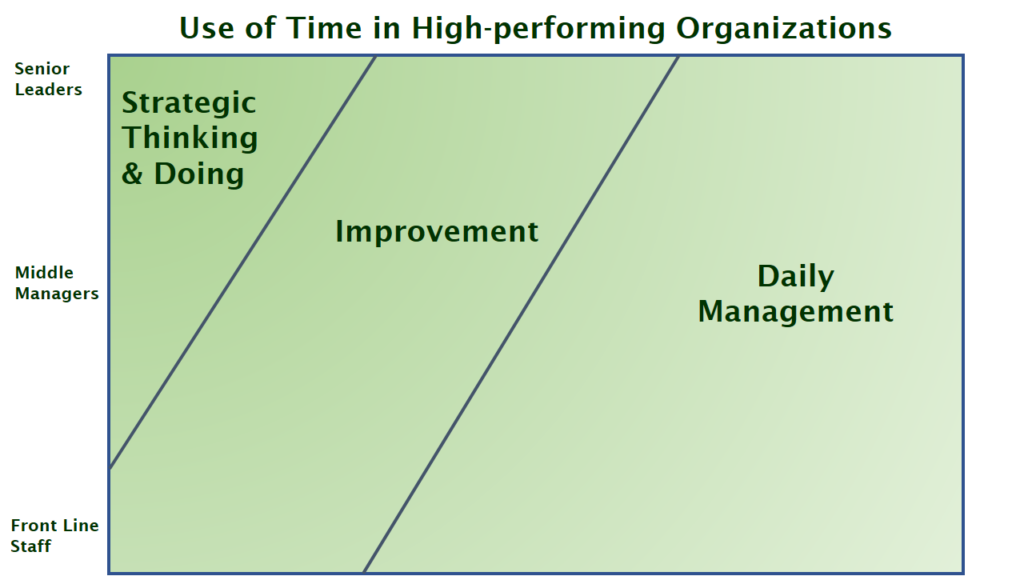How Do You Spend Your Time?
In working with a group of senior leaders recently at their strategic retreat, we were discussing their Use of Time.
We were looking at how they have typically used their time versus what I find as the distribution of time in high-performing organizations.
Given that they are seeking to transform to become a high-performing organization – striving for benchmark level performance in all outcome areas of quality, service, growth, financial health, and workforce – they were intrigued by how they might need to reconsider their Use of Time.

Strategic Thinking & Doing
In high-performing organizations, senior leaders spend about one third of their time strategically.
Thinking about and exploring new possibilities: new offerings, new markets, new models for workforce stability, and the like.
They formally scan the internal and external environments, analyze findings and make prudent predictions, and engage in strategic planning.
Senior leaders also spend a considerable amount of this time in strategic doing. CEOs often are involved in building key partnerships for bringing new services to new geographic areas. CFOs and COOs are often key to new business endeavors by modeling and working on the logistics for new service lines.
Middle managers (of which there are typically different types along the vertical side of this diagram — from directors to managers to supervisors) spend some portion of their time in the strategic realm in higher performing organizations. They might play a key role in the environmental scan or be a key participant in launching a new service.
Improvement
In high-performing organizations, senior leaders spend about one third of their time on improvement – leading, guiding and overseeing efforts to make the work we do more effective, more efficient, more customer-centric.
Most often, I find in improvement-focused organizations, that senior leaders serve as improvement initiative sponsors. They model the use of the improvement approach and coach and mentor improvement project leaders.
They serve to remove barriers that improvement teams encounter. They act as a sounding board to the improvement team and especially for the improvement lead.
Occasionally, depending on the size and scope of the organization, senior leaders serve as the lead on high visibility and high-risk improvement projects. In doing so, they model the value of drawing out the ideas and involvement of all who have a stake in the success of the effort. They work with their improvement teams to consider alternative solutions and run tests of change to validate effectiveness before wide-scale rollout of the chosen solution.
Middle managers in higher-performing organizations spend a fair amount of their time on improvement as is represented in the diagram. Examining and enacting ways to make the work processes of daily management much more effective. Not simply settling for the way we have always done things. They are not satisfied with good enough.
Daily Management
In high-performing organizations, senior leaders spend the final third of their time on Daily Management. Carrying out the daily management activities and processes that comprise their senior leader role.
For the CFO: ensuring the accuracy of financial reports, developing the budget, interfacing with the Finance Committee of the Board, actively participating in the audit process, and the like.
For the head of Human Resources: overseeing and guiding the recruiting, retention, and compensation processes. Handling high profile employee relations matters.
Middle Managers spend a larger portion of their time in daily management. This includes scheduling staff, hiring and onboarding new staff, carryout of their managerial duties specific to their roles.
Front Line Staff
What you may notice in this graphic is that in high-performing organizations front line staff play a significant role in improvement work. They are closest to the customers and therefore are a vital part of efforts to make things more effective. They serve on localized and often organization-wide improvement efforts. Their involvement is sought out and highly valued.
Putting This To Use
One of my very best clients, the CEO of a regional behavioral health organization, keeps this graphic pinned next to his monitor as a weekly reminder. He asks “Did I spend my time in this way over the past week? month?” If not, how can I restructure the coming weeks to ensure adequate attention on the future, not just on the present day challenges.
Another client, the CEO of a community health center, uses this graphic in conversations with his senior leader direct reports. Together, they discuss how they can move more toward this allocation of time by instilling processes in the organization for a fact-based approach to management rather than a “supervisory” style of daily management.
Yet another new client is beginning to explore: what would it take to focus more of our time on Improvement and Strategic Thinking & Doing. How would we have to manage differently? Where would we need to develop our approaches, our teams, our middle managers to run with Daily Management in a more functional manner. How can we move to monitoring daily management through key performance metrics rather than direct hands-on supervision?
And still another, who is both a business owner and key contributor, recently noted in discussing this Use of Time graphic that he really has two jobs: one as a senior leader and another (full time) role as a front-line contributor. Ah…no wonder he never feels he has time to get it all done and constantly feels like he is letting the business down.
________________________________________________________________
Often when sharing and discussing this Use of Time graphic, someone invariably says, “But I am already working 110% and it is all in Daily Management with the very occasional improvement effort when things are significantly broken.”
Yes, this is what I often see in most organizations that I begin to work with. This is very common.
I am not espousing you work 160% to achieve this distribution of time. But rather over time as you instill an Improvement Capability and establish a highly effective approach to Strategic Execution that those aspects of your leadership responsibilities will become a pivotal and essential part of your role.
But it will likely be essential to also re-examine how you manage the day-to-day, including:
- how you delegate,
- how you use key metrics to monitor processes and ensure improving results,
- how you work with your teams to systematize work processes, and
- how you create an environment of high-performance in your work areas..

If you’d like to receive these Inspirations in your inbox every other week, you can subscribe to Kathy’s Excellence Advantage Inspirations Newsletter.
Kathy Letendre, President and Founder of Letendre & Associates, advises organizations and leaders to create their excellence advantage.
Contact Kathy by phone or text at 802-779-4315 or via email.

